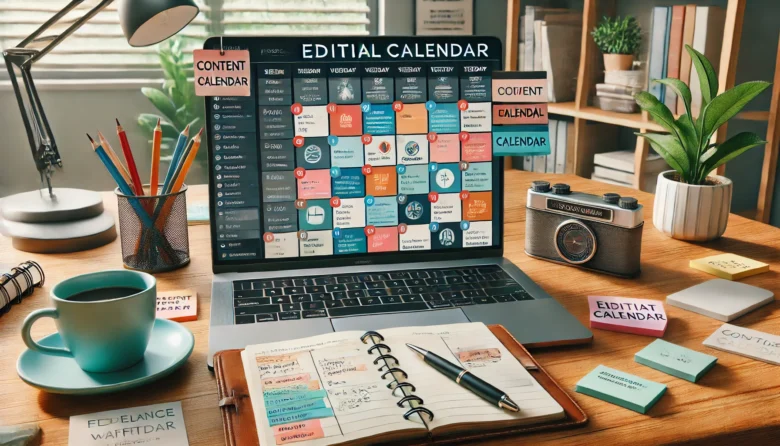When you’re juggling multiple clients, personal projects, and tight deadlines, it’s easy to feel overwhelmed and disorganized. That’s where a content calendar comes in—it’s one of the most powerful tools a freelance writer can use to bring structure, clarity, and focus to their workload.
In this article, you’ll learn how to build and use a content calendar that works whether you’re managing one blog or writing for several clients at once.
What Is a Content Calendar?
A content calendar (also known as an editorial calendar) is a visual plan that outlines:
- What content needs to be created
- When it’s due or scheduled for publication
- Who it’s for (client or your own project)
- What stage the content is in (idea, writing, editing, etc.)
It’s not just for social media managers or marketers—freelance writers can benefit massively by using it to organize their writing life.
Why Freelance Writers Need a Content Calendar
Here are a few big reasons:
- Keeps you on track with deadlines
- Reduces stress and last-minute rushes
- Improves communication with clients
- Helps balance client and personal projects
- Makes it easier to plan time for research and deep work
Even a simple calendar setup can transform your week.
Step-by-Step: How to Build Your Own Content Calendar
Step 1: Choose Your Tool
You can go digital or analog. Some popular digital tools include:
- Google Calendar – Easy, color-coded, syncs across devices
- Trello – Great for visual workflows with checklists
- Notion – All-in-one workspace with custom databases
- ClickUp – Powerful for tracking multiple projects
- Airtable – Combines spreadsheets with calendar views
Prefer something simple? Even a spreadsheet or printable monthly calendar can work.
Step 2: Define Your Calendar Categories
These will help you filter and organize your content. Common categories include:
- Client name or project
- Content type (e.g., blog post, email, case study)
- Status (idea, writing, editing, published)
- Deadlines and delivery dates
- Word count or effort level
- Platform (WordPress, Medium, social media)
Color-code or tag each category to make the calendar easier to scan.
Step 3: List All Your Upcoming Projects
Start by inputting everything that’s already in your pipeline:
- Confirmed assignments
- Self-published articles or blogs
- Recurring client content
- Guest post pitches
- Passion projects
Add the due date (or proposed date), client, title or topic, and current status.
Step 4: Create a Weekly and Monthly View
The weekly view helps you stay focused day-to-day, while the monthly view gives you the big picture.
For example:
| Date | Task | Client | Status |
|---|---|---|---|
| Apr 3 | Write SEO blog on coffee trends | Client A | In progress |
| Apr 4 | Edit case study draft | Client B | Scheduled |
| Apr 5 | Personal blog: Freelance writing myths | Self | Idea |
| Apr 7 | Submit email copy | Client C | Ready to send |
This visual structure helps prevent overload and allows you to move things around as needed.
Step 5: Build in Flexibility
Life happens. Assign buffer days between writing and delivery deadlines. If something urgent comes up, you’ll have wiggle room to rearrange.
Use task statuses like:
- “To Do”
- “In Progress”
- “Needs Edits”
- “Delivered”
- “Paid”
This allows you to track where each piece stands in the pipeline.
Bonus Tips for Freelancers Using a Content Calendar
🧠 Schedule Creative vs. Admin Days
Group writing-heavy days and admin/editing days separately to protect your deep focus time.
⏰ Set Reminders
Most calendar tools allow reminders. Set them for 1–2 days before deadlines to avoid last-minute stress.
📊 Track Metrics (Optional)
If you’re managing your own blog or newsletter, track:
- Traffic
- Engagement
- Publishing frequency
This helps you optimize your writing strategy over time.
🤝 Share With Clients (If Relevant)
If you’re managing content for a client, create a shared view so they can:
- See what’s coming
- Approve titles in advance
- Track project progress
Notion, Trello, and ClickUp are excellent for this.
Final Thoughts: Make Planning a Part of Your Process
A content calendar isn’t about restricting creativity—it’s about making space for it. By staying organized, you’ll have more time and mental clarity to write your best work, meet deadlines with confidence, and grow your freelance writing business without the chaos.
Start simple, stay consistent, and adjust your system as you grow. The calendar is your map—and as a freelancer, you’re the one behind the wheel.



